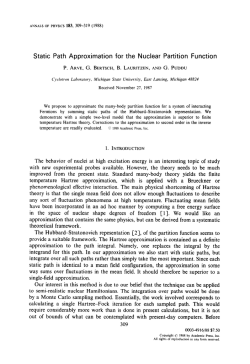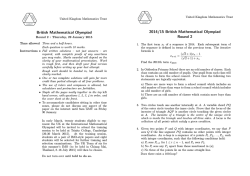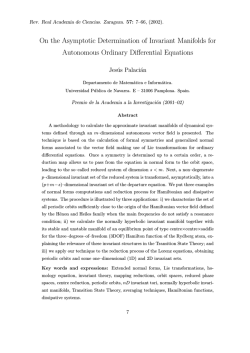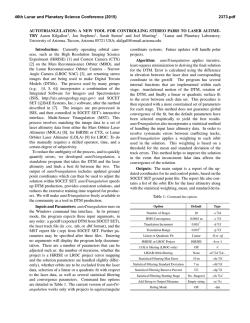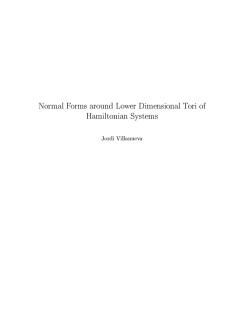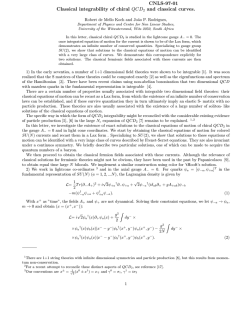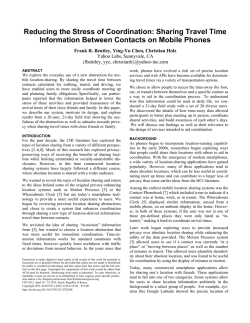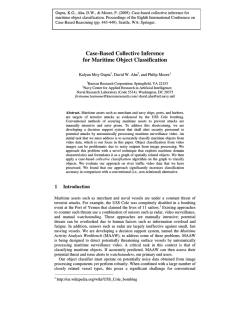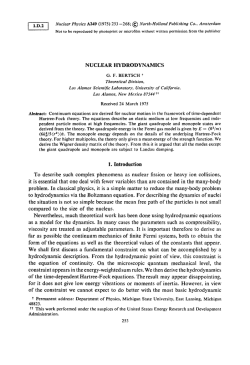
20. - Institute for Nuclear Theory
ANNALS OF PHYSICS: 63, 534-540 (1971) The Relation Between Classical and Quantum Mechanical Rigid Motion* GEORGE F. BERTSCH+ Joseph Henry Laboratories, Princeton University, Princeton, New Jersey 08540 Received October 14, 1970 Conditions are given on a quantum-mechanical system which effectively reduce the Hamiltonian to a rigid body Hamiltonian derived with classical mechanics. INTRODUCTION In several quantum systems the question arises of finding a well-known classical collective Hamiltonian as an approximation to the microscopic quantummechanical Hamiltonian. The classical collective Hamiltonian of few coordinates is derived by assuming the system is rigid in all but a few coordinates. Although this will not be exact for the quantum system, it may be a reasonable limit of the actual dynamics, and it is useful to know what assumptions it involves. A particular case which has received much attention is the rotational energy of a nucleus [l]. This has been treated often by specialized techniques not applicable to other types of rigid motion. We will show below a general technique to reduce a quantummechanical Hamiltonian to a rigid Hamiltonian by straightforward approximations. These approximations separate the collective and intrinsic motion in a way quite analogous to the Born-Oppenheimer approximation for molecular and electronic motion [2]. The Hamiltonians are defined by contact (nonsingular) coordinate transformations from the Hamiltonian of point particles. Thus the method is useful where the collective coordinates can be defined by a transformation. Unfortunately the general problem of nuclear rotation cannot be treated this way, since the collective coordinates are not well-defined. We will discuss several cases in nuclear physics where the method is applicable, involving the alpha-particle model of nuclear structure. * Work supported in part by the U. S. Atomic Energy Commission and the Higgins Scientific Trust Fund. +Alfred P. Sloan Foundation Fellow, 1969-1971. 534 REID MOTION 535 HAMILTONIANS THE HAMILTONIAN We first review the classical Hamiltonian theory of rigid motion. starts with the Lagrangian of point particles, L = 3 c mii(q - The theory V(..* xi .*.). (1) We shall make a coordinate transformation x + f, , and then go to the Hamiltonian representation. In terms of the new coordinates, the Lagrangian is L = g 2 .$G~~~TI,~~G~&- v(... & . ..). (2) ijk The matrix Gim is related to the coordinate transformation xi = xi(&) by (3) The new coordinates are separated into two groups: the 5, with c < i, which are collective variables, and the Si with i > i. , which are the remaining internal coordinates. The system is supposedto be rigid in the internal coordinates, allowing us to ignore them in passingto the Hamiltonian representation. We thus consider only the reduced Lagrangian, (4) To derive the rigid Hamiltonian, define the canonical momenta The Hamiltonian is related to the Lagrangian by the equation B = C P,& - L = * 1 &G~G& c<i, CC’&” + v. (6) This is expressedin terms of the canonical momenta by the quadratic form A = $ c Pc(M-l)cc, P, + V(*** & *..). cc’<io (7) The massmatrix appearing in this equation may be obtained from (5) and (6) and is (bP),,, = ((G+mG)ij<i,)-l. (8) 536 BERTSCH Note that this matrix is the inverse of the i0 x i0 submatrix of GmG, rather than the inverse of the full matrix. Turning to the quantum-mechanical problem, the semiclassical prescription is in the above Hamiltonian (7). Our object is to obtain to replace P, by %(a/@,) this result from the fundamental quantum-mechanical Hamiltonian, (9) This Hamiltonian is first transformed to the 5 coordinate system. This requires the relation between the gradient operator in different coordinate systems: where To derive the Pauli form of the transformed Hamiltonian, over the Hamiltonian density j- dv 09 Substituting = + ; C j dNxi & 2 (10) and then integrating ~dv(H?=~~~dn~lgI~I~G,;‘~p,~‘+<Y) P a =-- (Viq)* we consider the integral . (Viv) + (v). (12) by part yields j (13) ;j- dn~,g,~*Igl-‘CaIglG-‘~G-‘~‘P+(V>. ij ati a In these equations 1g 1 is the Jacobian of the transformation of coordinates. Omitting summation symbols, the new Hamiltonian density may be written, H= The Hamiltonian dynamics, -$;$[g[ G-lLG-‘&+ m is reduced by considering Hcc= - V. only the collective variables in the -!-- c ?- ,-1% G-l& 2 Ig I ce’<i,ati, + V, (15) RIGID MOTION 537 HAMILTONIANS This quantum-mechanical Hamiltonian may be compared with the classical Hamiltonian (7). One difference is the presence of the factors l/l g 1 x 1g 1 in the above expression (I 5). These factors are required to make the Hamiltonian density Hermitean, and do not concern us. A more important difference is that the mass matrix appearing in the quantum problem, G-1 r m G-1 , ee <i. = (WfGF1hc~~io (16) 3 is not identical to the mass matrix appearing in the classical problem, The reason the reduced quantum Hamiltonian is different is that the internal momenta have been set equal to zero, This is not consistent with classical rigidity, which requires the ti to be well-localized. To develop a better approximation, consider a wavefunction of the form The Z/ is a function only of the collective coordinates, and the localized wavefunctions in the internal coordinates. We take the y functions, in order to evaluate the matrix elements of a/at, and Formally, we approximate the potential in the internal coordinates potential and divide the Hamiltonian into three parts. CJI(E~- ti) are to be oscillator (i3/@J2 easily. by a quadratic H = ffcc + Hci + Hii ffci= C [g (G-lk G-‘),j& + (17) The part Hii acts only on the intrinsic coordinates, and Hci couples the intrinsic to the collective motion. We will now find the matrix elements of Hci and Hti to construct an effective Hamiltonian of the collective coordinates. If there were only one internal coordinate, the energy of the internal Hamiltonian and the matrix element of the internal momentum would be given immediately by (vi j Hii I vi) = ~[(G-l~n-lG-l),, (pi’ I ffii I R’> = # I fiw, I K]1/2 = ; fiwi (18) 538 BERTSCH Terms linear in the internal momenta occur in Hci ; these contribute to the ground state energy in second-order perturbation theory. We evaluate this second-order perturbation using the intermediate state energy of the intrinsic Hamiltonian. This, of course, is valid only if the excitation energy of the intrinsic Hamiltonian is large compared to the excitation of the collective part of the Hamiltonian. Using the matrix elements (18), the result for the second-order energy is Et2’ z -ff = & $ -!ct fiWi H. ‘O (19) (G-‘m-lG-l),i (G-lm-lG-l);l (G-lm-lG-l)i, c -+ . c Notice that this expression does not depend on the spring constant K. Equation (19) was derived for the case of only one internal coordinate, but is actually valid for an arbitrary number of internal coordinates when (G-lm-lG-l);l and (G-%z-~G-~),~ are interpreted as matrices. This may be seen by using a representation for the internal wavefunction in which Hii is diagonal. The final step in the construction of the effective Hamiltonian is to add the second-order correction (19) to the Hamiltonian (15) of the collective coordinates. Heri = Ho, + Et” = -; -$ c [(G-lm-‘G-l),, -(G- lm-l~-l),t (~-l~-l~-l);l (~--l~-l~-l)~~] +. &I The matrix in this Hamiltonian is identical to the classically derived mass matrix. This follows immediately from the formula for the inversion of a matrix by blocks, (21) With M = G-lrn-lG-l, our effective Hamiltonian (20) is obviously the inverse of the first block in (21); since the matrix itself is 44-l = (G-lm-lG-‘)-l = GmG, we recover the classical mass matrix (8). A specific example showing the relation of the two Hamiltonians occurs in the formulation of the three-body problem. The Hamiltonian can be expressed in terms of the center-of-mass coordinates, the three Euler angles of the triangle formed by the particles, and three further internal coordinates. When the RIGID MOTION 539 HAMILTONIANS orientation of the triangle is measured with respect to the principle inertia tensor, the Hamiltonian is of the form [3] H=,y+H(L,+) + z axes of the (22) Hii. 2 In this equation, Li are the angular momenta in the body-fixed system and the fi are the three internal coordinates. The moments of inertia Yi appearing in this Hamiltonian are the so-called hydrodynamic moments of inertia. These may be expressed in terms of the classical rigid body moments of inertia Z as follows, & = (4 - 42 * Ii . It follows from the previous section that an effective Hamiltonian with rigidbody moments of inertia may be obtained from (22) by treating the internal coordinates with oscillator functions and using second-order perturbation theory, This will be a poor approximation for the 3-nucleon problem, where the oscillator model is quite poor for the internal coordinates. It might be quite good for the 3 - LYmodel of 12C, however; the internal coordinates are concentrated at a definite position, and could be fairly approximated by oscillators. A second example of this correspondence occurs in an m-particle model of 160 [4]. The four a-particles are assumed to lie on two equilateral triangles with a common side. The angle between the triangles is allowed to vary. The classically derived Hamiltonian for this “hinged plate” model is HB = - a fi2 a + ;7e m,r2(& + fr CO? 6) ae V(... fi . . .). Here 0 is the angle between the two triangles. It is possible to make a coordinate transformation on the quantum-mechanical 4-body Hamiltonian to bring it to the form, H=-B 3 i + $ sin20 c? w,r 2 ae + H(l) (4) & 1 + *-. . As before, the massparameter in (25) is recovered by the perturbation treatment of H(l). However, the equivalence is not complete in this case. The zero point energy of the oscillators, $ Ci /iwi , depends on the collective coordinate 6. We thus find an extra potential energy that was not present in the classically derived 540 BERTSCH Hamiltonian. Also, the approximation of neglecting the energy of the collective part of the Hamiltonian in the energy denominator is not justified. In the ol-wavefunction, the other internal coordinates will be completely equivalent to the coordinate singled out as “collective”, and so all energies will be about the same. ACKNOWLEDGMENT The author acknowledges helpful discussions with B. Buck. REFERENCES 1. H. J. LIPKIN, A. DE SHALIT, AND I. TALMI, Nuovo Cimento 2 (1955), 133; S. TOMONAGA, Prog. Theo. Phys. 13 (1955), 467; F. VILLARS, Nucl. Phys. 3 (1957), 240. 2. M. BORN AND J. R. OPPENHEIMER, Ann. Physik 84 (1927), 457. 3. B. BUCK, private communication; W. ZICKENDRAHT, Ann. Phys. 35 (1965), 18. 4. W. BERTOZZI AND G. F. BERTSCH, to be published in Nucl. Phys.
© Copyright 2026
